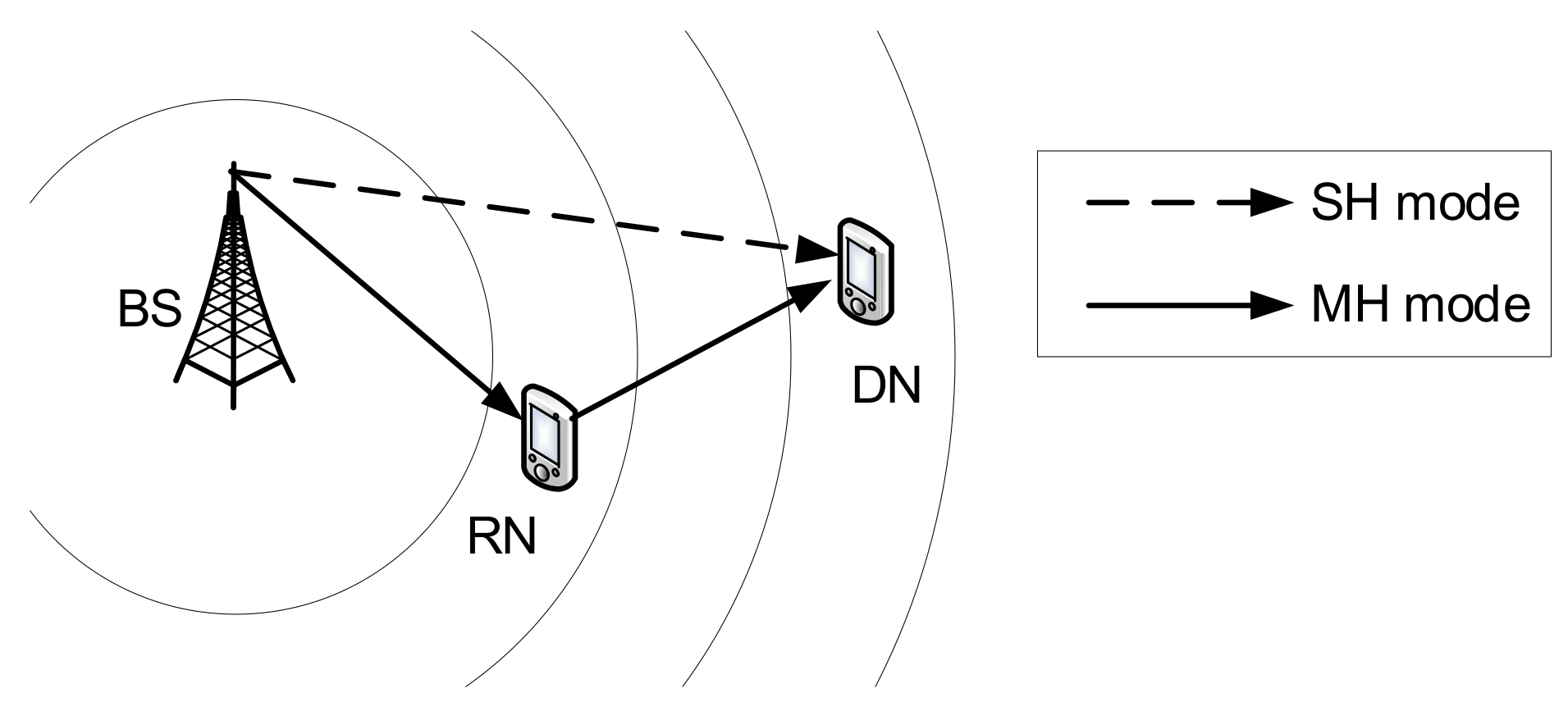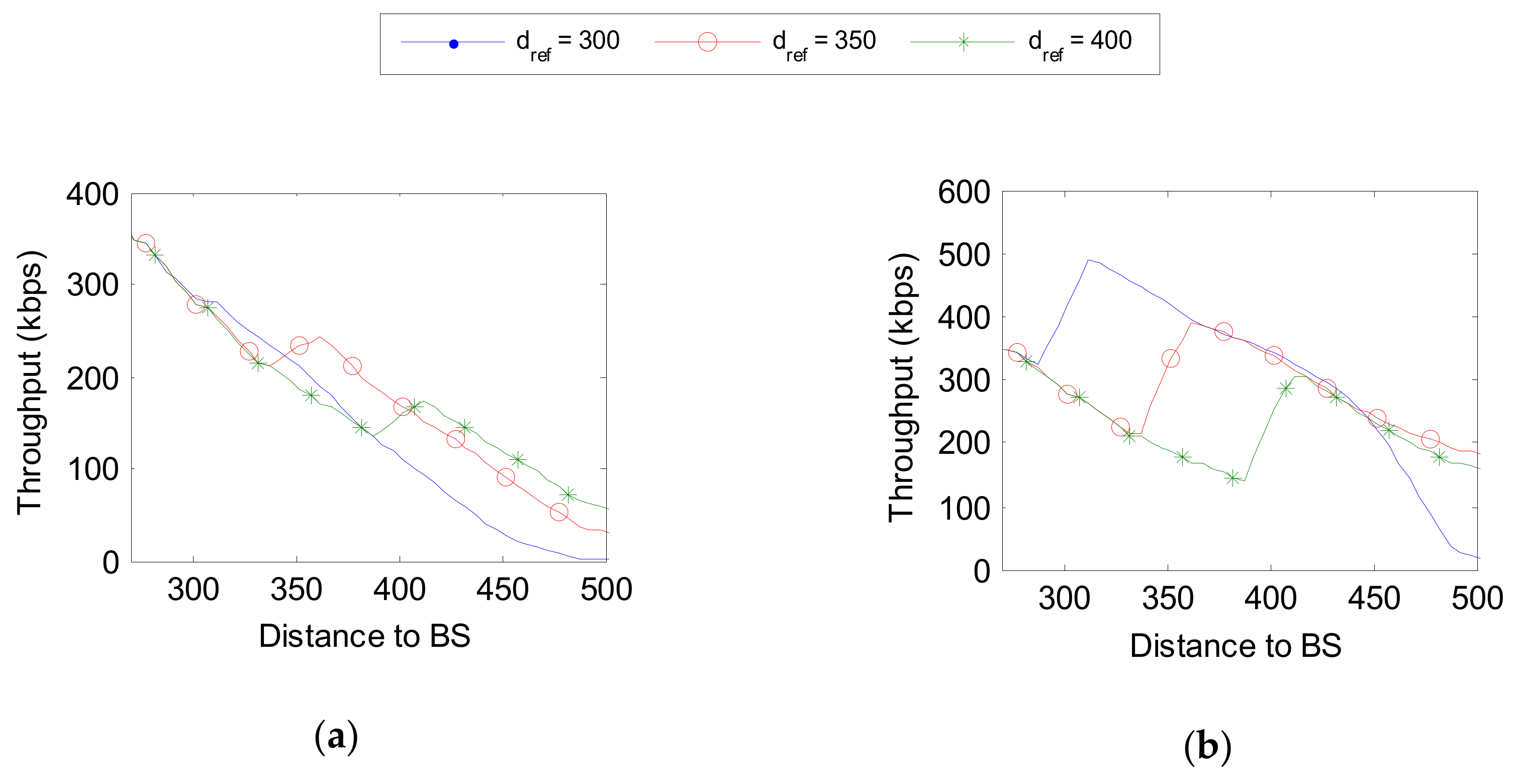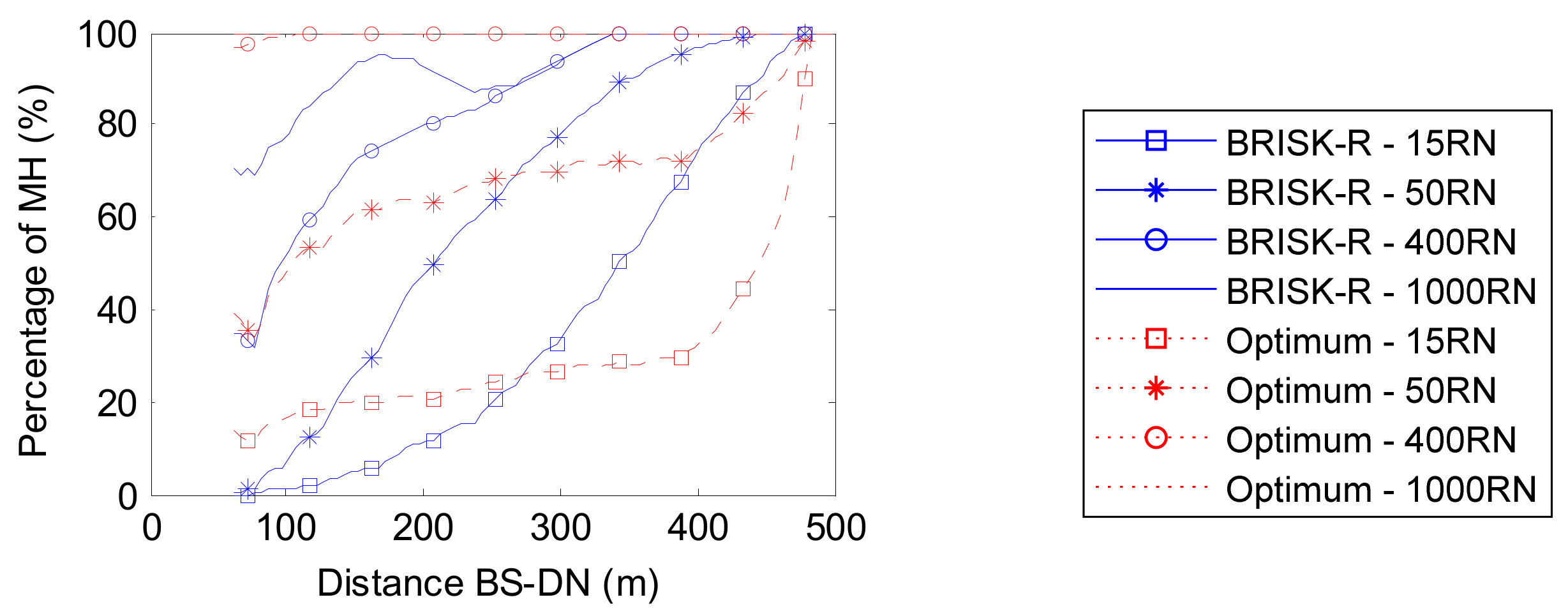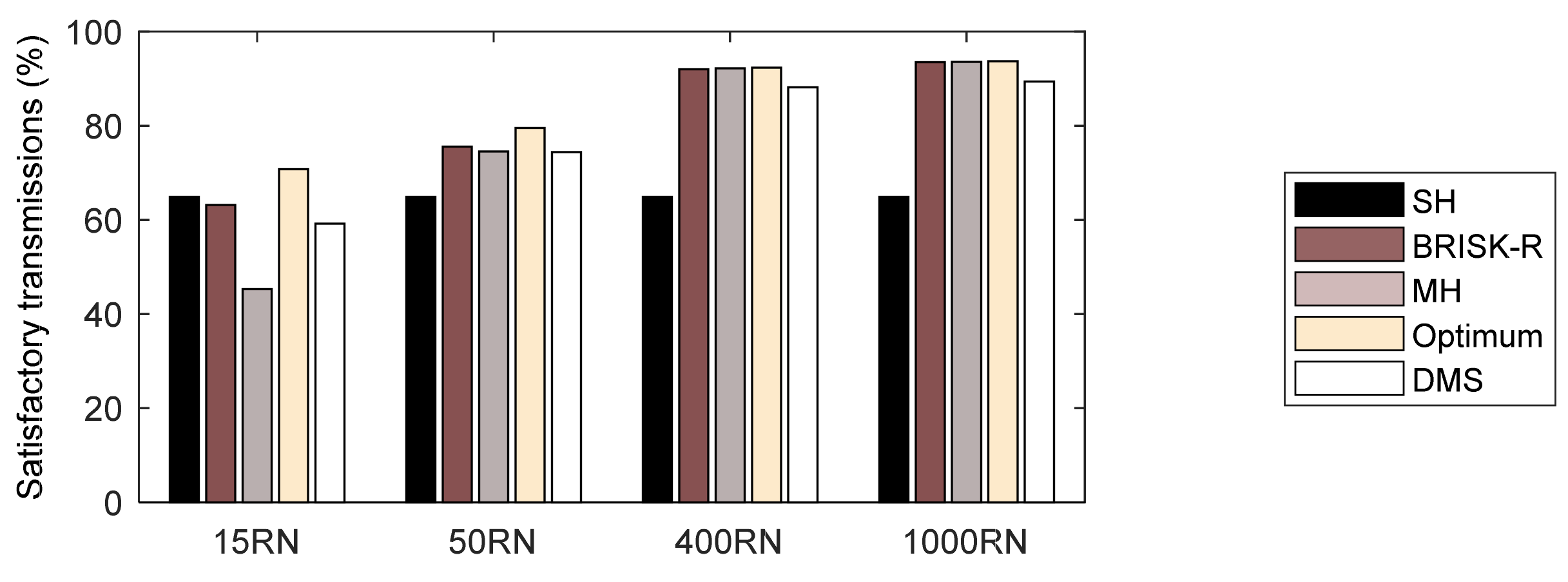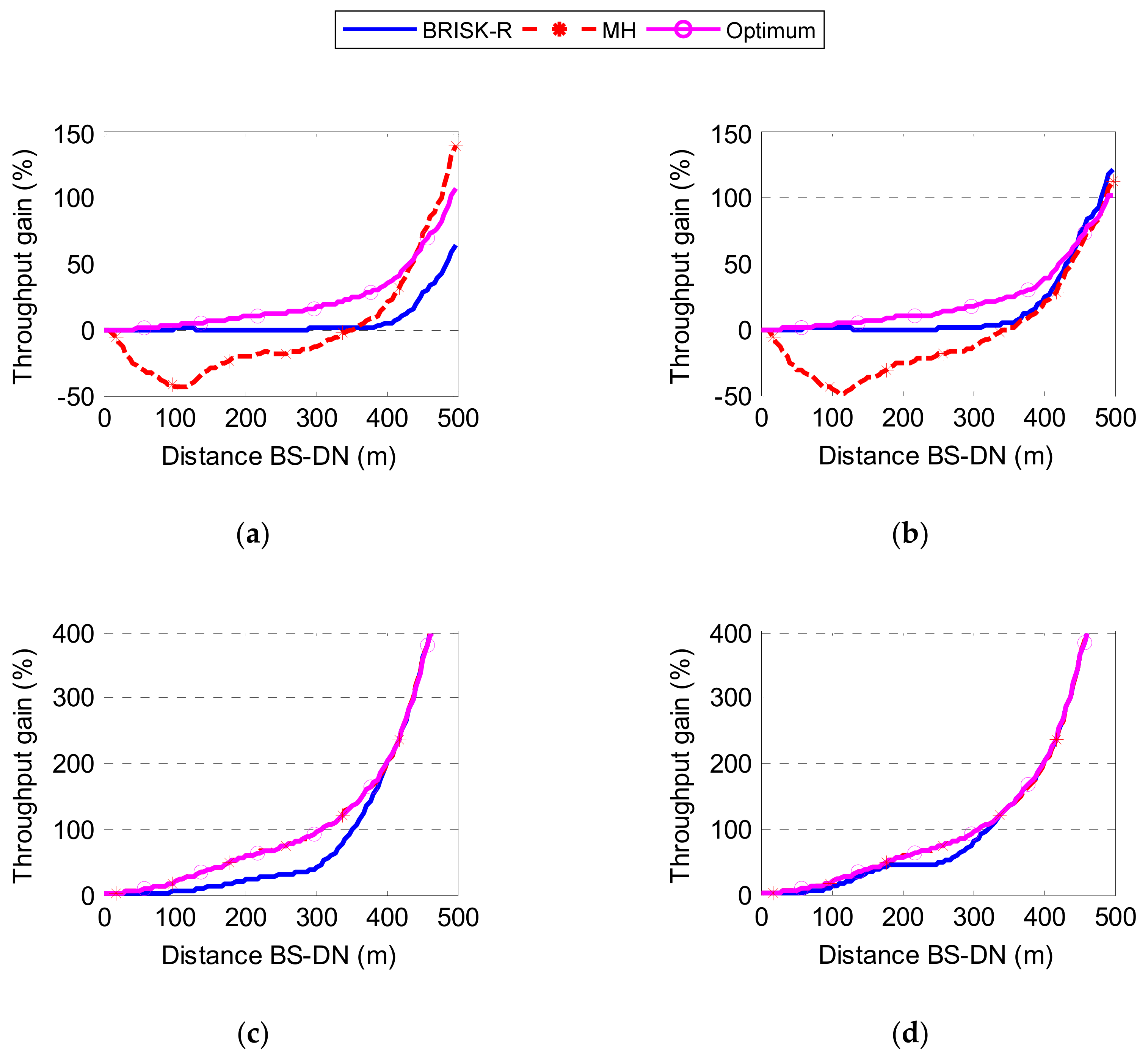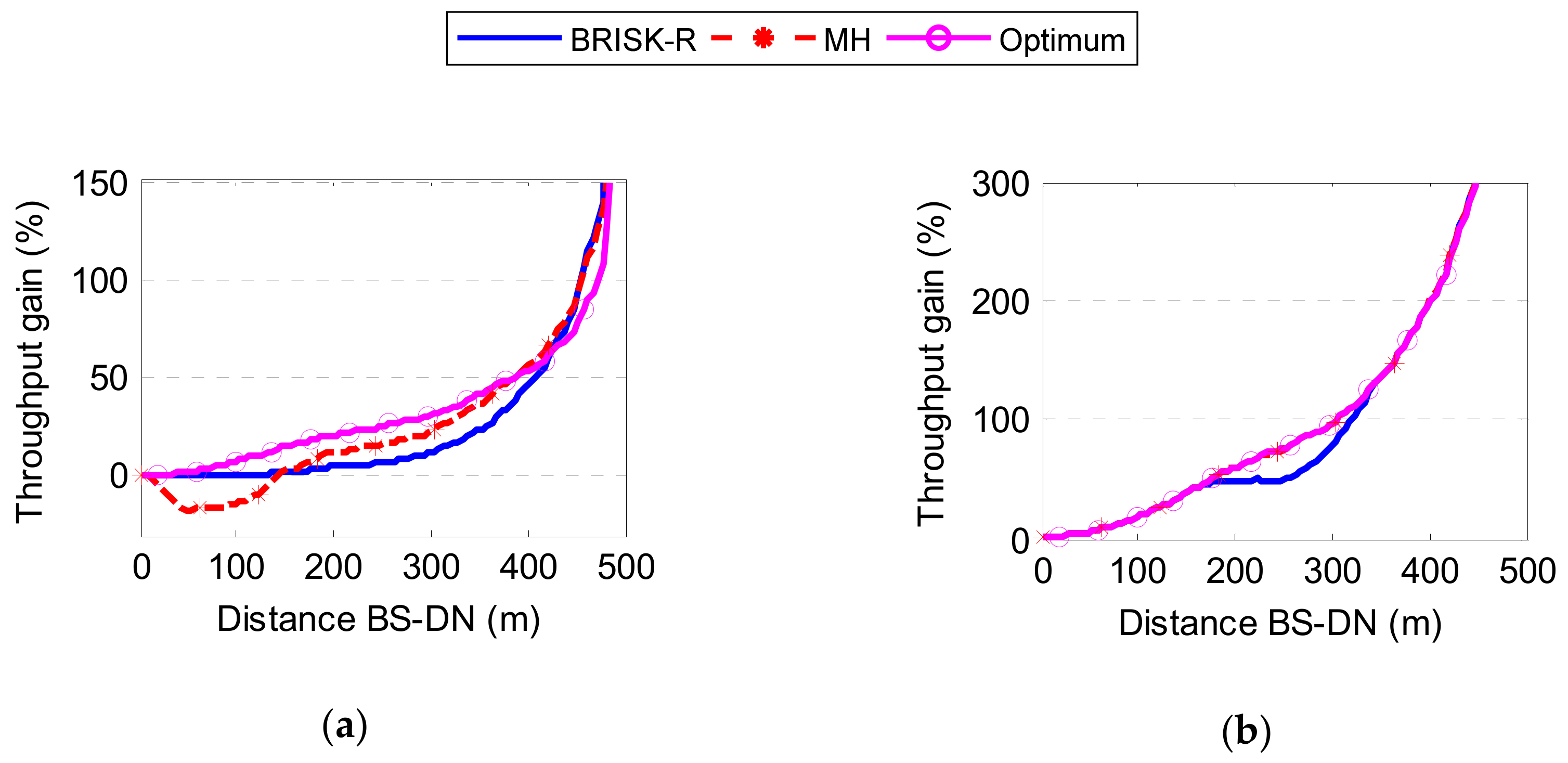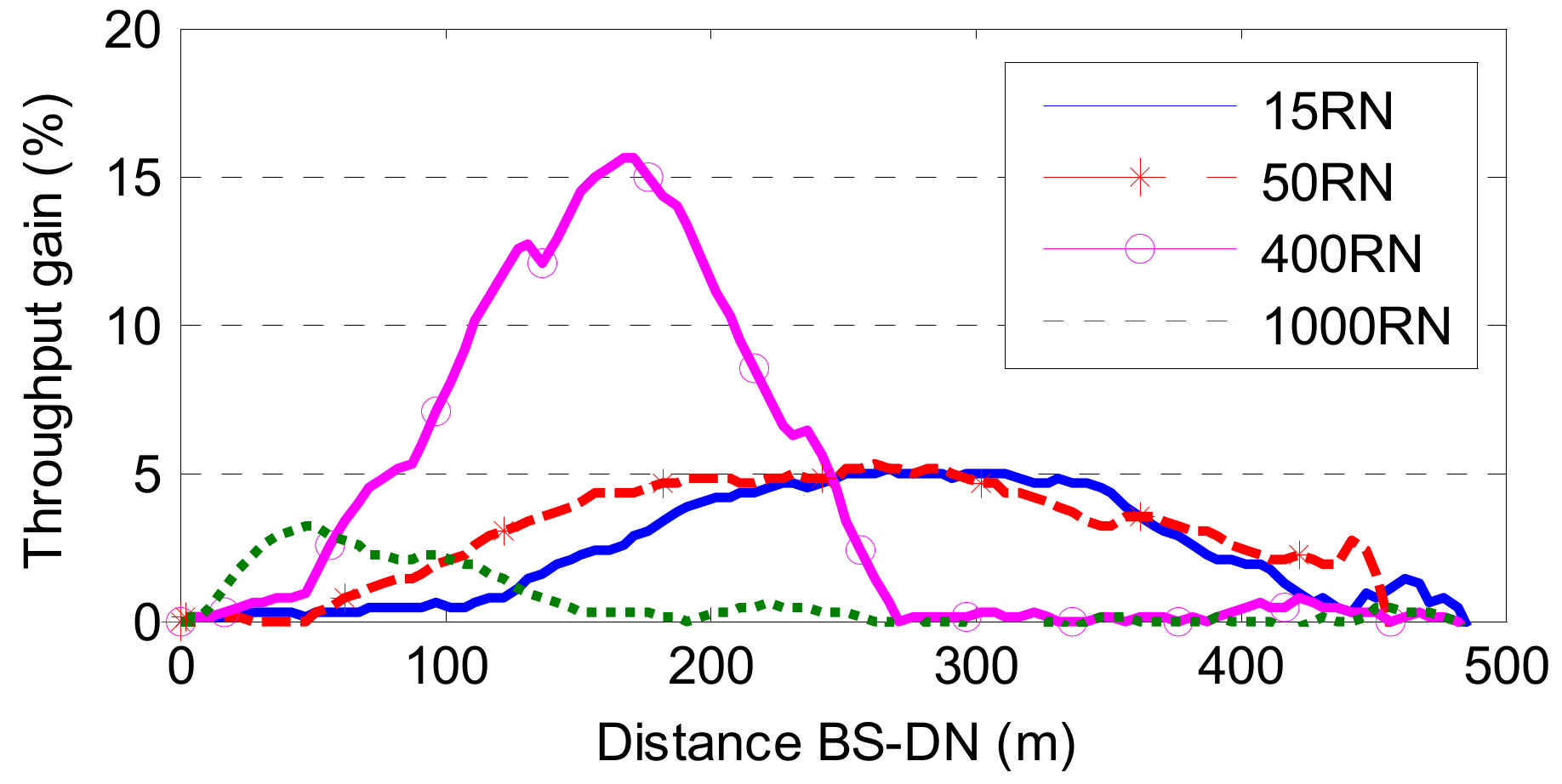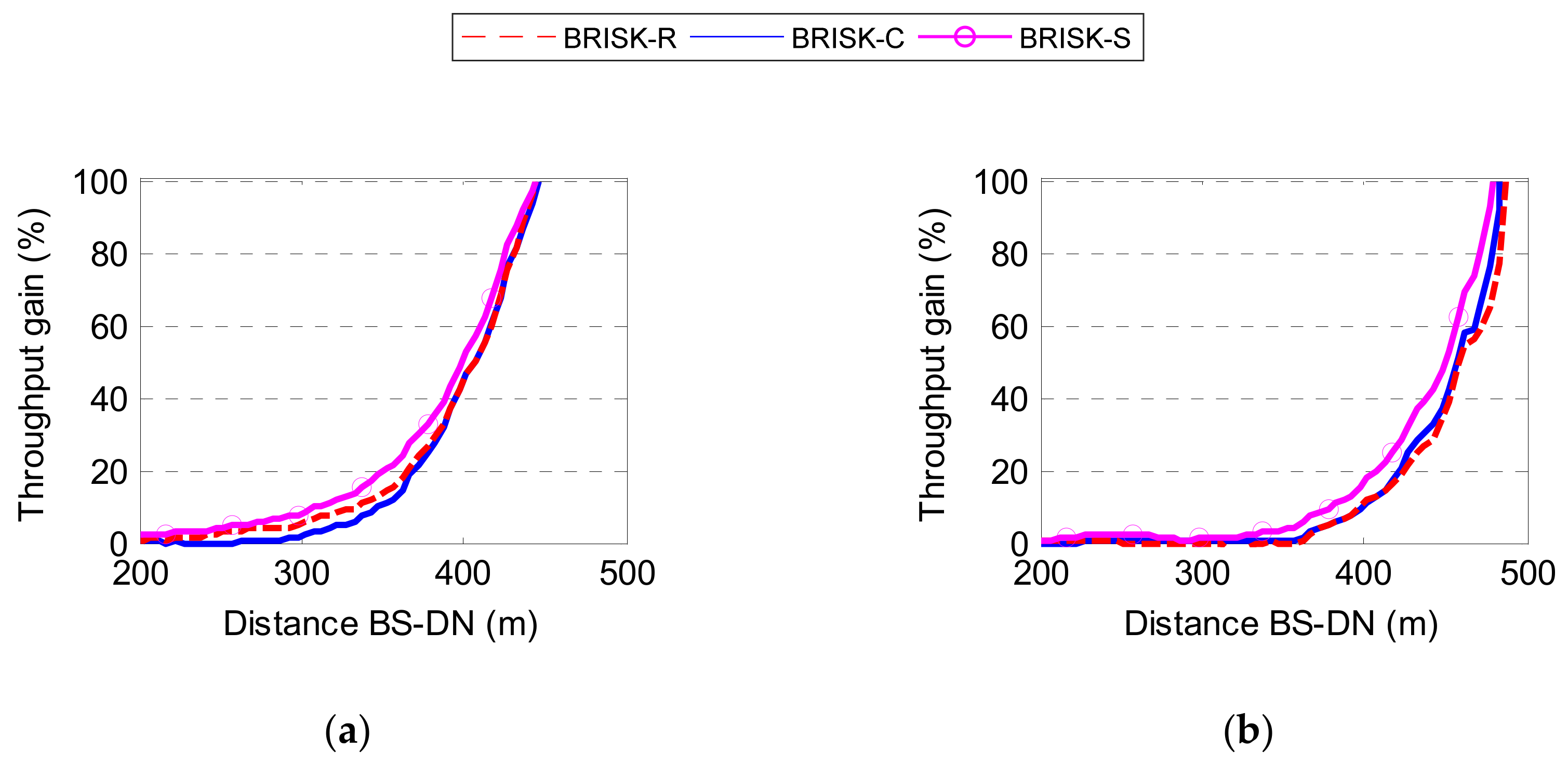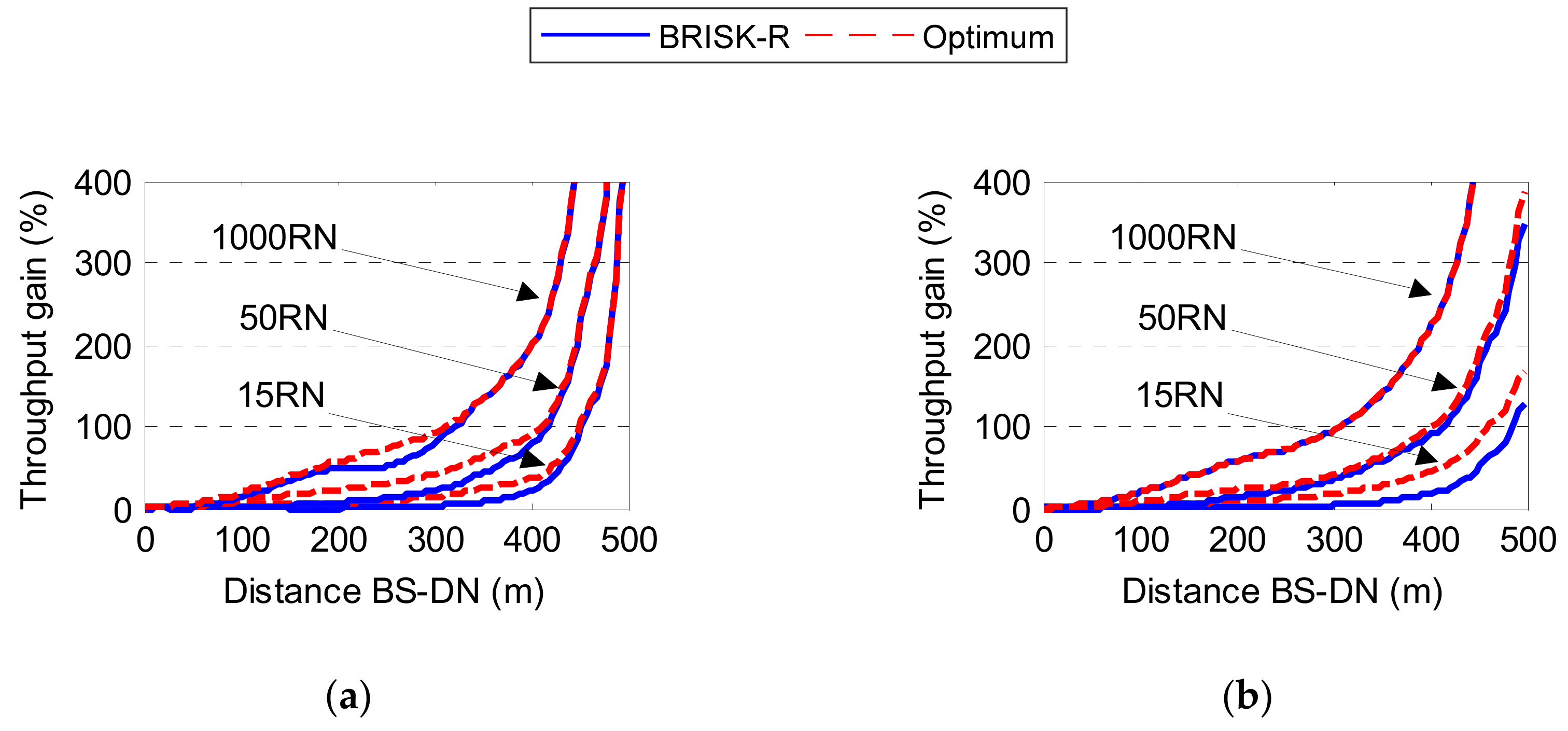1. Introduction
Currently, 5G and beyond networks are being designed to support the future increase of data traffic and service demands due, in part, to the emergence of machine-type communication devices such as sensors, robots or vehicles [
1,
2,
3,
4]. However, the general approach considered to date mainly relies on infrastructure-centric solutions [
5]. The infrastructure-centric approach reduces the infrastructure cost per bit and facilitates ultra-dense deployments of network nodes. However, to address the future data traffic demands, beyond 5G networks should consider complementing infrastructure-centric solutions with edge-centric ones [
6]. In fact, the role of edge-centric networks as a core component of 5G (and beyond) networks is recognized by European Technology Platform NetWorld 2020, for both computing and networking tasks [
7].
This idea of decentralization has been evolved by NetWorld2020 and the 5G Industry Association in their Smart Networks vision for 5G and beyond networks [
7]. Terminals or devices become a key part of future 5G and beyond networks as outlined in the Smart Networks vision: “not only should the terminal be able to fully exploit the new smartness of the network, but it should become, where suitable, an integral part of the realization of the latter, just like any other infrastructure resource” [
7]. This vision is fostered by the growing capabilities (e.g., computing, networking and context-awareness) of certain devices that can be used to support network functions. These devices include smartphones, and other 5G-enabled devices, such as smart sensors, robots, machines or vehicles. This vision moves the edge of the network to smart devices, to exploit their computing, storage and connectivity capabilities [
8]. Smart devices will then actively participate in the network management in coordination with the network infrastructure. A 3GPP study item under Release 17 proposes to explore device-centric solutions to improve the energy-efficiency and coverage of 5G scenarios and verticals such as inHome, Smart Farming, Smart Factories, Public Safety, among others [
9].
Device-centric technologies will provide 5G networks with adequate mechanisms to scale and handle the growing and very large number of connected devices and traffic demands [
10]. Device-centric technologies present new connectivity opportunities, where devices or User Equipments (UEs) will no longer be mere end-points, but will be integral parts of the network: devices will be consumers but also producers of both data and wireless connectivity [
7]. Device-centric wireless networks will change the traditional infrastructure-centric architecture. In device-centric wireless networks, devices will be able to communicate directly with other devices in proximity using device-to-device (D2D) communications [
11], or act as relays for other devices to connect to the cellular infrastructure in multi-hop cellular networks (MCNs) [
12]. MCNs are also referred to as UE-to-network relay in 3GPP standards. MCN is part of the 3GPP roadmap, e.g., to connect and manage machine-type communication devices [
13,
14]. The substitution of direct and generally Non-Line of Sight (NLOS) single-hop cellular links between a base station (BS) and an UE with various multi-hop D2D transmissions with improved link budgets provides high potential benefits in terms of Quality of Service (QoS), energy-efficiency and system capacity [
12]. It will be especially beneficial for machine-type communication devices, as it also affects the lifetime of battery powered devices [
15].
3GPP standardization efforts initially focused on proximity-based services [
16]. Release 14 has addressed further enhancements to the MCN concept for machine-type communications. However, further research in advanced management techniques is still necessary to efficiently integrate device-centric technologies into 5G cellular systems. In device-centric MCNs, devices have the possibility of establishing the communication with the BS through the traditional Single Hop cellular link (SH mode), in addition to the Multi-Hop connection (MH mode). The design of mode selection schemes that are able to dynamically select the best connection mode (SH or MH) will be key for the deployment of 5G MCNs to support the future Internet of Things. This paper contributes to fill this gap through the design and evaluation of a new mode selection scheme that enables the network infrastructure to select between SH and MH connection modes, taking into account the context of each device. To do so, the proposed scheme makes use of context information available at the BS, such as the density of nodes or the distance to the device, minimizing the signaling needed. Leveraging the concepts of benefits and risks, the proposed scheme selects the most adequate connection mode considering the deployment and operating conditions. The proposed scheme has been evaluated in this study under different node densities, different mobility models, different traffic demand types and different RRM schemes. Its performance has been compared to that achieved with four different reference techniques, demonstrating its capability to outperform existing solutions.
The structure of this paper is as follows.
Section 2 reviews the state of the art about mode selection for 5G cellular systems, including those considering MCN scenarios, and motivates the need of the proposed solution in comparison with existing studies.
Section 3 presents the mode selection scheme proposed in this work for 5G networks to integrate D2D and MCN. It also includes the methods designed to estimate the benefits and risks of the different connection modes and the interaction of the mode selection and RRM (Radio Resource Management) schemes considered in this work.
Section 4 describes the simulation environment used to validate the proposed solution.
Section 5 presents the four mode selection schemes that have been used as a reference to analyze the benefits of the proposed solution.
Section 6 presents the performance analysis conducted, which compares the performance and efficiency of the proposed solution with the reference schemes in different scenarios, considering different data traffic demands, exploiting different context information and considering different RRM schemes.
Section 7 summarizes the main conclusions obtained and the key benefits of the proposed solution.
2. Related Work
In the future beyond 5G network that integrates device-centric technologies, adequate mode selection schemes will be of paramount importance to maximize the overall system performance and satisfy the QoS demanded by the UEs. As an example of mode selection scheme, the work in [
17] considers a cellular system where UEs can connect to the BS through an SH or an MH link. The work in [
17] proposes that UEs always select the MH mode at the beginning of their transmissions considering its higher potential performance compared to the SH mode. During their transmissions, UEs monitor their experienced performance, and adaptively change to the SH mode if the experienced throughput is below the throughput that could be expected through the SH. This policy can be highly inefficient due to the additional signaling and communication delays required by the establishment of the initial MH connection and the change of the connection mode. The relevance of an adequate mode selection scheme is also highlighted in [
18]. This work proposes a scheme that selects the best connection mode for content delivery. Content delivery can be performed through a cellular multicast connection with the BS or through a 2-hop connection at which an UE caches and multicasts content to other UEs through D2D communications. The mode selection scheme proposed in [
18] selects the most energy efficient connection mode based on the estimated energy consumption per successful delivery. This work shows that by applying the proposed mode selection criteria, it is possible to reduce the energy consumption per successful content delivery up to 50% when compared with a random mode selection. Previous studies have shown that better (system or UE) performance and a more efficient use of the radio resources can be achieved when the connection mode is selected based on some information about the potential performance achievable with each available mode compared to select a predefined or random mode [
17,
18]. Some other studies such as [
19] propose mode selection schemes for HetNets, where small cells such as picocells, femtocells, etc. are deployed to offload marcocells, improve area coverage and provide high data rate transmission in hotspots.
Several studies have analyzed the problem of mode selection in cellular systems where UEs in proximity can establish a direct D2D communication or communicate through an SH connection. For example, an optimization problem is proposed in [
20] to jointly decide the connection mode for each UE (SH mode or D2D mode). The optimization problem aims to maximize the sum of the throughput experienced by the UEs. It also incorporates constraints to guarantee a certain degree of load balancing among the different BSs of the system. Another example is found in [
21]. In this work, two UEs in proximity can communicate using a traditional SH connection, or through a direct D2D connection with dedicated resources or sharing resources with other active cellular transmissions. In [
21], the authors aim to maximize the overall throughput experienced by cellular UEs and D2D UEs. To this end, the BS acquires information about the channel quality between each UE and the BS and between each pair of transmitter and receiver UEs. By using this information, the BS decides in each scheduling period the communication mode for each transmission, together with the allocated resources. The results achieved in [
21] showed that this proposal can significantly improve the system throughput and reduce the interferences between UEs. The results show that the use of dedicated resources for the D2D links is preferred to provide higher UE performance. However, when the number of UEs increases, the D2D links should share resources with the cellular links to increase the system capacity. The downside of this proposal is that the acquisition of the channel quality information of all possible communication links in the system has a non-negligible cost that can compromise the feasibility of the mode selection scheme. The work in [
22] proposes that an UE selects the direct D2D link if the pathloss of the D2D link is lower than the pathloss experienced between the UE and the BS. Authors of [
22] studied the impact of the errors of the pathloss measurements on the maximum effective communication capacity (i.e., the maximum sustainable constant arrival rate at the transmitter under QoS constraints). They demonstrated that the effective capacity exponentially decreases as the pathloss measurements become noisier.
The mode selection problem is different in MCN scenarios than in scenarios where only SH and D2D modes are possible. Trying to establish an MCN connection has the risk of not being able to find adequate relay nodes so that MCN communications improve the QoS compared to conventional SH communications. This risk can significantly impact the end-user QoS and generate unnecessary network signaling overhead. The integration of MCN in 5G and beyond networks requires the design of mode selection schemes capable to account for the expected performance gains that this connection mode can provide, but also for the risks of establishing MCN connections [
23]. Such potential performance gains and risks are strongly conditioned by the scenario and the context (e.g., by the density of nodes in the cell). Few studies tackle the mode selection problem in MCN networks. In cellular systems, UEs at the cell edge usually experience lower QoS levels compared to UEs close to the BS. Based on this assumption, a distance-based mode selection criterion for MCN is considered in [
24] and [
25]. The study in [
25] considers that the MH mode is always selected for UEs at distances to the BS higher than a given threshold, and it analyses mechanisms to select the UEs that will act as relay nodes for the MH connection. The same distance-based mode selection criteria are also considered in [
24], but using fixed relays. It is compared in [
24] against a mode selection scheme that selects the connection mode (SH or MH) that requires the lower number of subcarriers needed to obtain certain performance level in an OFDMA-based system. The results obtained demonstrate that mode selection decisions should not only take into account distance information, but also incorporate additional context information (such as link quality information). However, estimating and using the SH and MH link quality information can be significantly complex [
24]. This complexity can be significantly higher in MCN with mobile relays given the mobility of nodes, and the high number of possible mobile relays.
Interesting insights can be obtained from analytical studies that model and analyze mode selection schemes for MCNs. For example, an analytical framework for MCNs is developed in [
26] to study the transmission power consumption, relay probability and outage probability in the system. This framework was used to analyze the performance of a mode selection scheme that selects the MH connection for a given UE if the total power consumption of the links between the UE and the relay UE and between the relay UE and the BS is lower than the power of the cellular SH connection. Authors demonstrated in [
26] the accuracy of the theoretical analysis by comparing the analytical results with those achieved by simulation, and also demonstrated that the proposed mode selection scheme can reduce power consumption and outage probability. In [
27], the analytical framework presented in [
26] was evolved to model a caching enabled MCN. In this study, UEs select the MH connection to download content if there is an UE at a shorter distance than a given distance threshold from the BS. Otherwise, the UE will select the traditional SH connection. This study demonstrates that the distance threshold and the UE density have a great impact on the performance. Authors of [
28] propose a dynamic graph optimization framework that enables the modeling of large-scale MCN systems with multiple D2D pairs and node mobility patterns. In the modeled system, communication between BS and end UEs can be established through a direct SH cellular link or an MH connection. The proposed framework allows studying the optimal design of several technical problems in MCN, such as mode selection and resource allocation. The mode selection scheme proposed in [
28] aims at maximizing the total amount of data received by the end UEs. This proposal requires to know the evolution of the system (the evolution of the graph) to decide the optimum connection mode for each UE. The proposal of [
28] was not designed to be applicable in real systems but provides theoretical performance bounds.
Given the impact of the context conditions on the performance of the system, different studies, such as [
26,
27], propose a mode selection scheme based on perfect knowledge of the system: UEs select the MH connection if there is a relay node that reduces the power consumption [
26] or it is at a shorter distance from the BS [
27]. While they provide interesting insights, collecting and sending channel performance information for all possible D2D/MCN links in a cell can introduce high signaling and overhead levels when the number of UEs in the system is high.
To complement and evolve existing solutions, this paper proposes a mode selection scheme for MCNs that exploits information available at the BS to estimate the potential benefits and risks of the SH and MH connection modes for each UE. In particular, the proposed mode selection scheme exploits the distance between the BS and the end UE, and the density of nodes in the cell. This information is used by the proposed mode selection scheme to decide the most convenient connection mode for each transmission with a low signaling overhead.
3.3. Context Information
To calculate the expected performance of SH and MH modes for a given DNi, BRISK makes use of context information available at the BS. Following the system model previously described, the expected performance of both SH and MH depends on the distance between DNi and the BS. This distance can be estimated by the BS without additional signaling through the received signal strength of signaling and control messages exchanged with DNi.
The expected performance also depends on the probability of finding an adequate RN in a certain area close to DN
i, which was previously expressed as P
RN(·). This possibility highly depends on the UE distribution over the cell. This distribution is usually modelled through a uniform spatial distribution using a homogeneous Poisson process [
32]. Following this model, the number of UEs in a given area
A follows a Poisson distribution with parameter
ρ·A, being
ρ the average UE density in the scenario. In this case, the probability of finding at least one UE in a given area
A can be calculated with the following expression:
The only parameter needed to calculate P
RN(
A) is the UE density in the context of DN
i. If we consider that the UE density is constant over the cell, we can simply consider in Equation (17) the average UE density in the cell,
ρcell. The BS knows the number of UEs under its coverage, therefore it can easily calculate the average UE density as the number of UEs divided by the cell area:
Using Equations (17) and (18), BRISK can calculate the benefit and risk of an MH connection for a given DN in a scenario where the UEs are uniformly distributed. However, the movement of the UEs could result in non-uniform UE distributions, creating areas with higher number of UEs, which are known as attraction areas or hot spots. These areas could correspond to e.g., shopping centers or working areas. In this type of scenario, the distribution of the UEs in area
A that is significantly smaller than the cell coverage area (i.e.,
A ) could also be considered homogeneous [
33]. Therefore, the probability of finding at least one UE in a given area
A could be still calculated with Equation (17) following the Poisson distribution. However, the average UE density in the cell does not accurately reflect the UE density in cells when the UEs are not uniformly distributed. To improve the accuracy of the estimation of P
RN(·) in these scenarios, we propose to further exploit context information available at the BS. Based on the estimated distance from the BS to the UEs in the cell, the BS can estimate the UE density in the ring that intersects with the area where the adequate RN would be located. This ring is determined by the distances
din and
dout illustrated in
Figure 3, that correspond to the distances from the BS to the closest and farthest points of the area
Ai(
r2), respectively. The UE density in this ring can be then calculated with the following equation:
where
represents the number of UEs located at a distance to the BS higher than
din and lower than
dout.
BRISK can also go one step further to exploit additional context information to improve the accuracy of the benefit and risk estimation. Most of the current cellular deployments consider cells with multiple sectors and this information can be exploited by BRISK to better estimate the UE density in the proximity of the DN. More specifically, the BS can estimate the UE density in each ring for each sector using the following equation:
In this equation, s represents the sector where the DN is located, and S represents the total number of sectors in the cell. represents the number of UEs in sector s at a distance d to the BS so that din d < dout. The BS has direct access to context information that can be used to calculate ρcell, ρring and ρsector so that BRISK can estimate the UE density accurately in different conditions.
3.4. Interaction Between Mode Selection and RRM Schemes
The performance that can be achieved with either the SH or the MH mode highly depends on the number ci of radio resources assigned for the transmission. ci is used for the direct link between BS and DN i in the case of SH, and for the cellular link between BS and RN in the case of MH. As a consequence, the SH and MH performance depend on the RRM policy implemented to distribute the radio resources. In fact, advanced RRM solutions usually takes into account the performance that an UE could obtain to decide the number of radio resources to be assigned, which in turn depends on the connection mode used (SH or MH). Given their mutual influence, we need to define how they interact.
The mode selection scheme needs to first identify the optimum connection mode
for all possible radio resource assignments, i.e., for all possible values of
c ∈ [1,
C], with
C representing the maximum number of available cellular radio resources in the cell. As a result, the expected performance for each possible radio resource assignment
c can be expressed as:
The values calculated with Equation (22) by the mode selection scheme are used by the RRM scheme to decide the number of resources for each DN
i. This can be formulated with the following equation that represents the performance
Qi of DN
i as a function of a set of binary variables
:
The RRM scheme needs to compute each . will be equal to one if DNi is assigned c radio resources, and equal to zero if not.
4. Evaluation Environment
The performance of BRISK has been evaluated in this study with a discrete-event C++ system-level software simulator. The scenario simulated considers an omnidirectional BS of 500m radius that is deployed in the center of the scenario [
34]. The SH mode and the cellular link between the BS and RN in MH mode make use of the LTE technology. The LTE MCSs associated to the 15 CQI values defined by 3GPP in [
35] have been implemented. The MCS selected depends on the distance between BS and DN (for an SH connection) or between the BS and RN (for an MH connection), and they therefore depend on the rings where they are located.
The link between the RN and the DN in MH mode makes use of out-of-band D2D communications using IEEE 802.11 g. The simulator considers the throughput model proposed in [
31] to model the MH throughput as a function of the distance between the RN and the DN (presented in
Section 3.2. This model considers
r1 = 150 m as established in [
31] based on real measurements.
r2 is calculated with Equation (8) using the empirical model presented in [
31]. To establish an MH connection, the BS first searches for an RN within
Ai(
r1). If it cannot find any RN in this area, it continues the search within
Ai(
r2). In both cases, if there are several candidate RNs within the corresponding area, the BS selects the RN that is closer to it. Finally, if no RNs are found in
Ai(
r2), the selected RN is the closest UE to DN
i among all the UEs that are located at a shorter distance to the BS than DN
i. An MH connection with an RN located out of
Ai(
r2) provides lower throughput levels than an SH connection. In a practical implementation of the proposed mode selection scheme (and any other mode selection scheme), these situations could be detected to automatically switch to mode SH. In this study, we have not implemented this solution to avoid hiding the performance achieved by the mode selection scheme in all scenarios as a result of a good or bad mode selection.
As detailed below, the proposed scheme, BRISK, has been compared with four different reference techniques considering four different UE densities, three different mobility models, two different traffic demand types and two different RRM schemes.
4.1. UE Density and Mobility
The different UE densities presented in
Table 1 have been evaluated in order to analyze the capability of the proposed mode selection scheme under different operating conditions. In these scenarios, a fixed number of 10 DNs demanding transmissions is considered for all the simulations.
To evaluate and compare the performance of the proposed solution under different uniform and non-uniform UE distributions, three different scenarios have been considered (that result from the application of different mobility models):
Homogeneous scenario: RN and DN UEs move following the Random Direction model [
36]. This model considers that the UEs move at a constant speed and direction through the cell. The speed is randomly chosen between 0 and 3m/s and the direction is randomly selected between 0 and 360°. When an UE reaches the edge of the cell, it selects a new speed and direction to continue moving within the cell. This mobility model results in a uniform distribution of UEs within the cell.
Circularly symmetric scenario: RN and DN UEs move following the Random Waypoint mobility model [
33]. This model considers that each UE selects a random destination within the cell and it then moves towards the selected destination at a constant speed randomly chosen between 0 and 3 m/s. When an UE reaches its random destination, it randomly chooses a new destination and a new speed. The Random Waypoint mobility model produces a non-homogeneous distribution of UEs within the cell, since UEs tend to concentrate at short distances to the center of the scenario, i.e., at short distances to the BS. Therefore, the resulting UE distribution is circularly symmetric centered at the BS.
Figure 4a shows the UE density as a function of the distance to the BS for this scenario. In this figure, the UE density is normalized by the average UE density in the cell,
ρcell.
Non-symmetric scenario: in this scenario, RN and DN UEs move following the Random Waypoint mobility model previously described but evolved considering the existence of an attraction area. The probability that an UE randomly chooses a destination inside the attraction area is
p = 10 times higher than outside it. The attraction area is a circle with 200 m radius centered in location (200 m, 60°) using polar coordinates, considering that the BS is in the origin. This mobility model produces a non-homogeneous scenario that has a higher UE density in the attraction area, as shown in
Figure 4b. In this case, there is no circular symmetry with respect to the BS.
4.2. Traffic Demand
The traffic demand can also have an impact on the performance and operation of a mode selection scheme. To demonstrate the validity and compare the performance of BRISK with the performance of the reference techniques under different conditions, the following traffic demand types have been considered:
Web traffic: All DNs request web browsing sessions following the model reported in [
37]. The average time between sessions has been set equal to 10 s.
Mixed multimedia traffic: DNs request web browsing and email sessions following the models reported in [
37] and [
38] respectively. The average time between sessions has been set equal to 15 s for both traffic types.
4.3. RRM Schemes
The absolute system performance depends on the RRM scheme considered. To avoid limiting the performance evaluation to a single RRM scheme, this study considers the following 2 RRM schemes proposed in the literature:
MAXIHU [
30]: this scheme was initially proposed for heterogeneous networks and has been adapted in this study to decide the number of radio resources to be used by each active transmission (SH or MH). MAXIHU was designed to provide the highest possible homogeneous performance to all UEs. This is achieved by MAXIHU by defining an optimization problem with an objective function that maximizes the multiplication of the performance perceived by all active UEs in the system (
n represents the number of active UEs in the cell):
To be able to apply integer linear programming techniques, Equation (24) can be expressed linearly as [
30]:
The problem defined and solved by MAXIHU is used to decide which variable is set to 1 for each DNi, and therefore the number of resources, ci, that will need to be assigned to each UE. The values of the Qi(c,di) are calculated by BRISK before applying MAXIHU. The restrictions of the optimization problem take into account that only one variable can be equal to one for each UE. They can also incorporate different priorities to differentiate UES requesting different services (this is only applied in scenarios where it is not possible to guarantee the same QoS performance level Qi(c,di) to all UEs). If the optimization problem does not have a solution, the active UE located at a highest distance to the BS is removed from the RRM process, until a solution to the optimization problem is found.
MinP [
39]: This RRM scheme is designed to guarantee a minimum QoS performance to all UES. To this aim, MinP assigns to each DN
i the number of resources that are necessary to achieve a throughput of
Thmin (3Mbps) which can be expressed as:
where
Qi(
c,
di) is calculated by BRISK before applying MinP. If all active UEs cannot obtain this minimum throughput, again the active UE located at a highest distance to the BS is removed from the RRM process, until a feasible solution is found.
5. Reference Mode Selection Schemes
The performance of BRISK is compared against the mode selection schemes described below. For all schemes, changes between connection modes are not allowed in order to focus on the impact of the mode selection process.
Traditional SH communications (SH). This scheme is used as a reference to compare the proposed scheme against that obtained when operating traditional SH cellular communications.
MH communications (MH). This scheme was proposed in [
17] and it always selects the MH connection mode, given the higher potential performance compared with the SH mode.
Optimum mode selection. This is an ideal scheme that has perfect knowledge of the DN context and is used to perform optimum selection decisions. To do so, it only selects the MH mode when it provides an improved link budget compared with the direct SH link.
Distance-based mode selection (DMS) [
24,
25]. This scheme has been implemented as in [
25] for MCN. It is designed to select the SH mode for those DNs located at a distance to the BS shorter than certain
dref. If the distance between the DN and the BS is larger than
dref, the MH mode is selected. In this case, the RNs selected must be closer to the BS than DN, and the distance RN-DN must be shorter than the communication range of the D2D link. The performance of DMS highly depends on the
dref parameter. Different values between 300 m and 400 m have been evaluated in order to select the best one for the comparison with the rest of mode selection schemes.
Figure 5 shows the average throughput per assigned cellular radio resource achieved by the DMS scheme as a function of the distance of DN to the BS. The results are shown for different
dref values, considering the 50 RN and 400 RN scenarios with a homogeneous UE distribution and web traffic. Based on the results obtained,
dref has been set to 350 m in the rest of this study, because it achieves a better compromise under low and high UE density scenarios.
